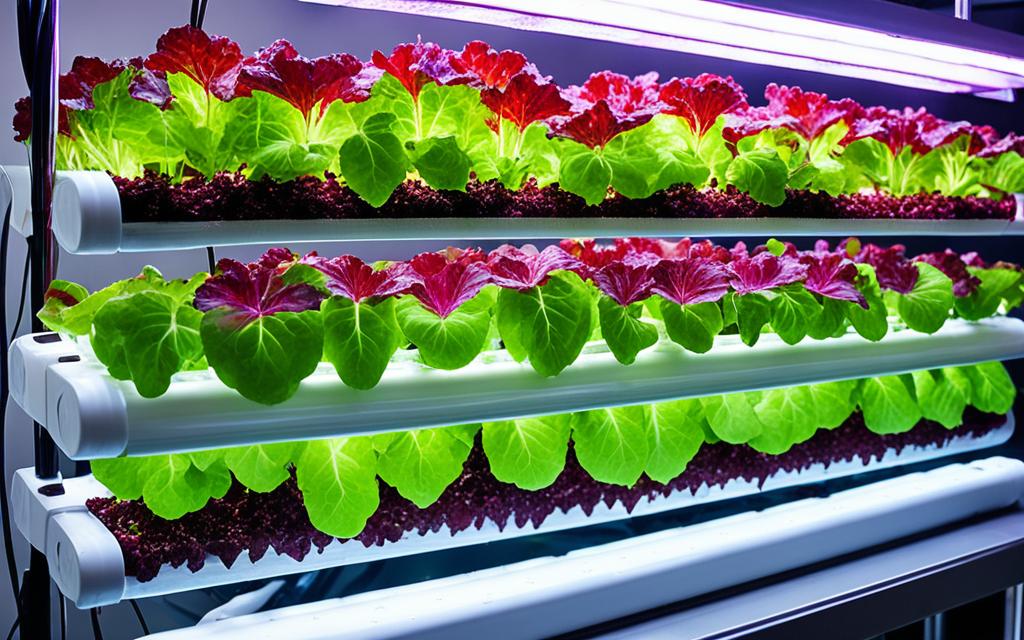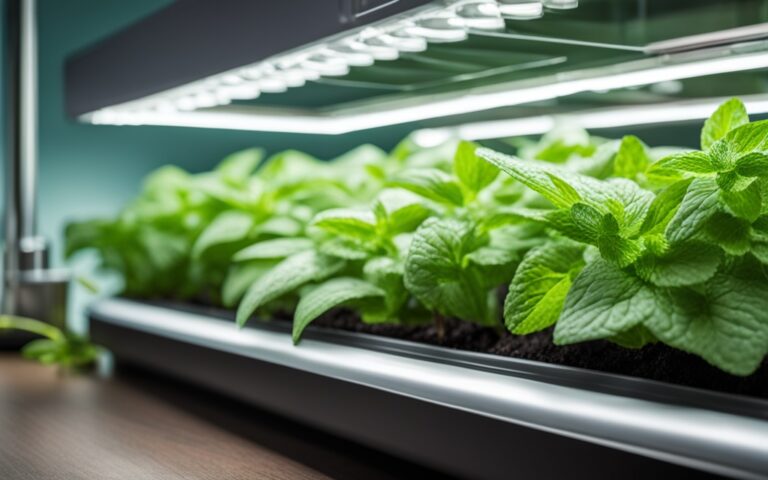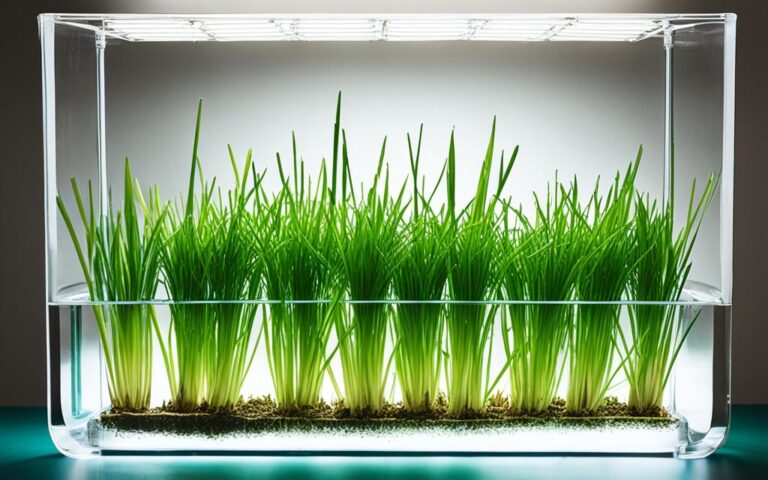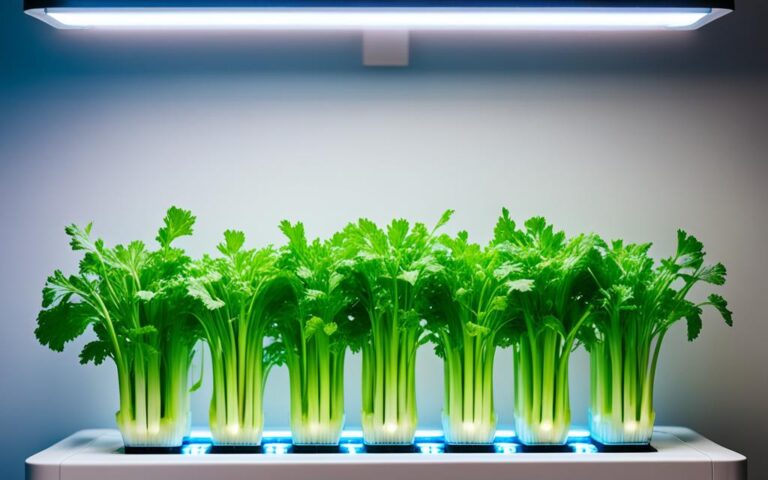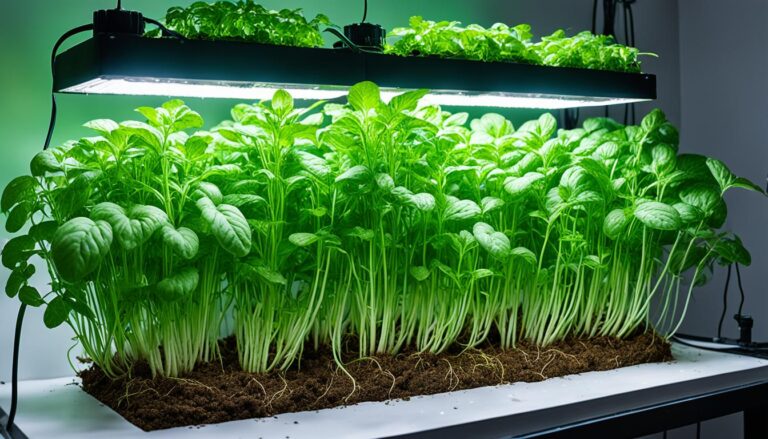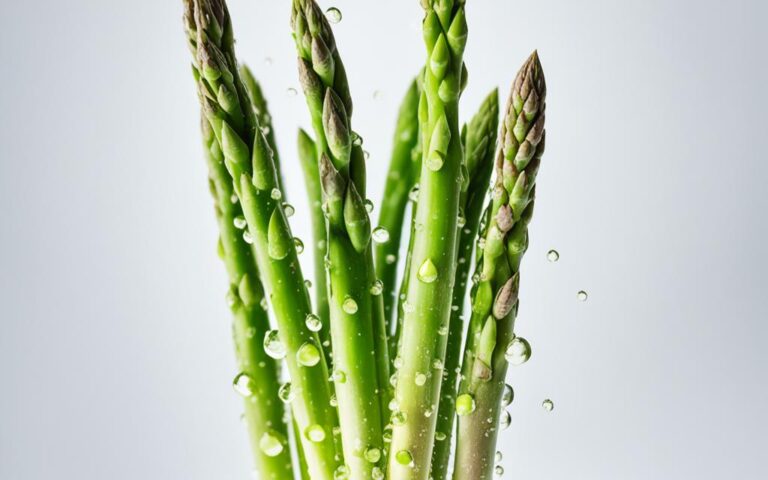Grow Hydroponic Red Leaf Lettuce Successfully
Did you know a single acre of hydroponic lettuce can produce up to 25 times more than traditional farming? This shows how powerful hydroponic technology is in changing how we grow food. Red leaf lettuce is loved for its bright color, soft texture, and unique taste. By learning how to grow hydroponic red leaf lettuce, you can have a lot of this fresh, healthy lettuce at home.
Key Takeaways
- Hydroponic red leaf lettuce offers exceptional growth rates and higher yields compared to traditional soil-based farming.
- Red leaf lettuce is a nutrient-dense leafy green with a delightful flavor and vibrant color.
- Hydroponic systems provide the ideal environment for growing red leaf lettuce, allowing you to control all the essential growth factors.
- Proper nutrient management, lighting, temperature, and air flow are crucial for successful hydroponic red leaf lettuce cultivation.
- Regular monitoring and adjustments to the growing conditions can help you maximize the health and productivity of your hydroponic red leaf lettuce plants.
Selecting the Right Variety
Choosing the right variety of hydroponic red leaf lettuce is key to success. These varieties are loved for their bright colors, small size, and ability to thrive in controlled settings. They make your hydroponic garden look great and taste amazing, adding a peppery flavor to salads and sandwiches.
Hydroponic Red Leaf Lettuce Cultivars
Here are some top hydroponic red leaf lettuce varieties:
- Red Sails – A classic red leaf lettuce with ruffled, burgundy-colored leaves and a sweet, mild taste.
- Ruby Sky – A compact, upright variety with deep red leaves that hold their color well, even in low-light conditions.
- Rouxai – A vibrant red lettuce with a slightly serrated leaf edge, known for its uniformity and tolerance to bolting.
- Crisp Red – A crunchy, deep red lettuce with a slightly spicy flavor, perfect for adding a pop of color to your hydroponic garden.
Starting from Seeds vs. Transplants
You can start hydroponic red leaf lettuce from seeds or transplants. Seeds need to be germinated in a medium like a hydroponic starter plug or tray. This method gives you control over the growing process but takes longer to harvest. On the other hand, transplants can give you a quicker harvest but need to adjust to the hydroponic setup first.
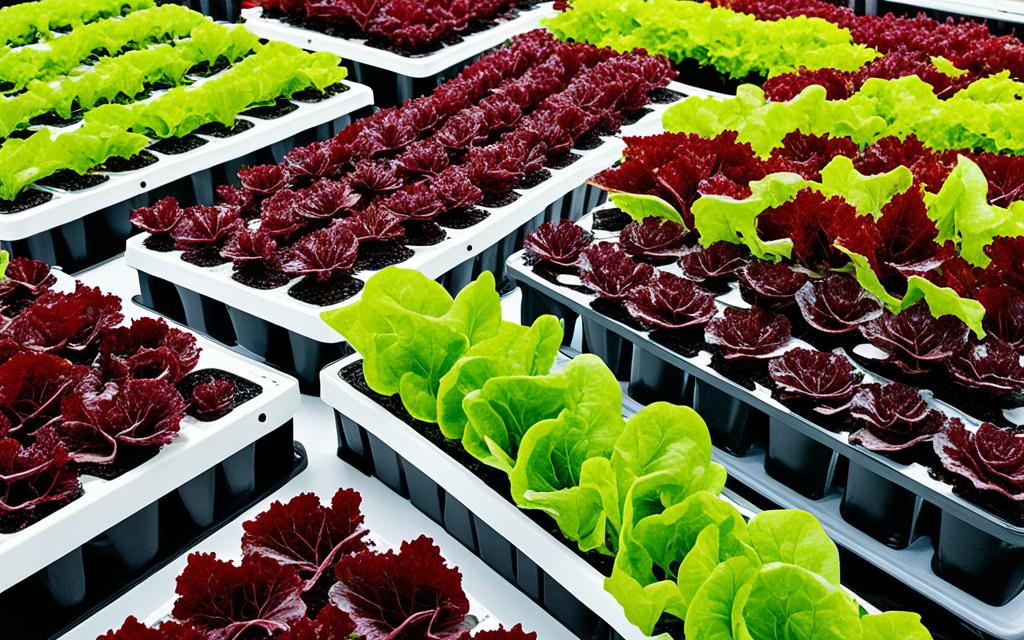
“The key to successful hydroponic red leaf lettuce cultivation is selecting the right variety and starting method that aligns with your growing conditions and preferences.”
Setting Up Your Hydroponic System
Setting up a hydroponic system for red leaf lettuce needs the right gear and setup. There are many hydroponic systems for this leafy green, each with its own benefits and things to think about.
Types of Hydroponic Systems for Lettuce
Some top hydroponic systems for growing red leaf lettuce are:
- Deep Water Culture (DWC): Plants hang in a solution full of nutrients with their roots in it.
- Nutrient Film Technique (NFT): A thin stream of nutrient solution flows over the plant roots constantly.
- Drip Systems: Nutrients drip slowly onto the plants’ growing media.
- Wick Systems: A wick pulls the nutrient solution from a reservoir to the plant roots.
Essential Components for a Lettuce Hydroponic Setup
No matter the hydroponic system, you’ll need certain key parts to grow red leaf lettuce well:
- Growing Medium: This helps support the roots, like rockwool cubes, perlite, or coconut coir.
- Nutrient Solution: A special nutrient mix for hydroponic lettuce or leafy greens.
- pH and EC Meters: To check and fix the pH and electrical conductivity (EC) of the nutrient solution.
- Lighting: The right lighting, natural or artificial, for the best growth.
- Ventilation: Good air flow to keep the right temperature and humidity.
- Clean Water Source: A clean, safe water supply is key.
By picking the right hydroponic system and gathering the needed parts, you can make a setup that’s efficient and grows healthy, top-quality red leaf lettuce.
Nutrient Management
Keeping the right balance of nutrients is key for your hydroponic red leaf lettuce to grow well. These plants need a mix of important nutrients to do well in a hydroponic setup.
Essential Nutrients for Hydroponic Red Leaf Lettuce
Lettuce needs nitrogen (N), phosphorus (P), and potassium (K) the most. Nitrogen helps leaves grow big and strong. Phosphorus and potassium help roots grow, stems get stronger, and plants stay healthy.
Other important nutrients like calcium, magnesium, iron, and boron are also crucial. They help with different body functions.
Preparing and Monitoring Nutrient Solutions
To make the best nutrient solution for your lettuce, you must adjust the nutrient levels. The ideal pH for lettuce is between 5.5 and 6.5. You also need to check the electrical conductivity (EC) to get the nutrient levels right.
Testing and adjusting the nutrient solution often is key. It keeps your hydroponic lettuce plants healthy and productive.
| Nutrient | Concentration Range | Importance |
|---|---|---|
| Nitrogen (N) | 100-200 ppm | Promotes leaf growth and development |
| Phosphorus (P) | 40-80 ppm | Supports root growth and overall plant vigor |
| Potassium (K) | 150-250 ppm | Enhances stem strength and disease resistance |
| Calcium (Ca) | 80-120 ppm | Strengthens cell walls and improves leaf quality |
| Magnesium (Mg) | 30-50 ppm | Necessary for chlorophyll production and photosynthesis |
Lighting Requirements
Getting the right lighting is key for growing healthy hydroponic red leaf lettuce. This type of lettuce needs a lot of light to grow well. Most lettuce types do best with 12 to 16 hours of light each day.
If you’re growing your hydroponic red leaf lettuce indoors or in a place with little sunlight, you’ll need extra light. LED grow lights are a great option. They give the right kind of light for plants to make food.
When picking grow lights for your hydroponic lettuce, choose ones that give a wide range of light colors. This includes red and blue light, which plants need to grow. Make sure the lights can give enough light, measured in micromoles per square meter per second (μmol/m²/s). This is important for hydroponic red leaf lettuce.
| Lighting Requirement | Recommended Intensity (μmol/m²/s) |
|---|---|
| Seedling Stage | 200-300 |
| Vegetative Growth | 300-500 |
| Mature Plant | 400-600 |
By giving your hydroponic red leaf lettuce the right amount of light, it will get the energy it needs. This helps it grow well and gives you a big harvest.
Temperature and Air Flow
For growing hydroponic red leaf lettuce, it’s key to keep the temperature and air flow right. This cool-season crop does best in a moderate temperature. It needs specific conditions during the day and night.
Ideal Temperature Range
The best temperature for hydroponic red leaf lettuce is 60°F to 70°F in the day. At night, keep it a bit cooler, between 55°F and 65°F. This keeps the leaves from getting bitter and stops the plants from growing too fast.
Ensuring Proper Ventilation
Good air circulation is also vital for hydroponic red leaf lettuce. It stops humidity from building up, which can cause mold and diseases. Using fans or making sure there’s enough airflow helps plants grow strong and healthy.
| Parameter | Optimal Range |
|---|---|
| Daytime Temperature | 60°F to 70°F |
| Nighttime Temperature | 55°F to 65°F |
| Air Circulation | Adequate ventilation with fans or airflow |
By keeping the temperature right and ensuring good air flow, growers can create perfect conditions for their hydroponic red leaf lettuce. This leads to a big and high-quality harvest.
Planting and Transplanting
Starting your hydroponic red leaf lettuce can be done from seeds or transplants. If you pick seeds, put them in a growing medium like rockwool cubes or coconut coir. Keep them moist until they sprout.
Germinating Seeds in a Growing Medium
Germinating hydroponic red leaf lettuce seeds needs a medium that holds moisture and lets air in. Rockwool cubes or coconut coir work well because they support and hold water for the seedlings. Keep the medium moist but not too wet to help seeds germinate and roots grow.
Transplanting Seedlings into the Hydroponic System
When the hydroponic red leaf lettuce seedlings have a few big leaves and strong roots, it’s time to move them to the hydroponic setup. Be gentle when moving them, making sure the roots are covered in the nutrient solution. This careful handling helps reduce stress and makes the move easier for your plants.
Choosing the right growing medium and paying attention to germination and transplanting affects your hydroponic red leaf lettuce’s success. By doing things right, you set your lettuce seedlings up for a healthy and productive life in the hydroponic system.
“Proper handling and transplanting are crucial to minimize stress and ensure a smooth transition for your hydroponic red leaf lettuce plants.”
Monitoring Plant Growth
Watching the health and growth of your hydroponic red leaf lettuce is key to their success. Keep an eye out for signs of nutrient problems or imbalances. These can greatly affect how well your plants grow and the quality of your harvest.
Signs of Nutrient Deficiencies
Look for signs like stunted growth and leaves that are not their usual color. Yellow or reddish-purple leaves might mean there’s not enough nitrogen. Brown or necrotic spots could indicate a lack of calcium or magnesium. Checking your plants often can help you spot and fix nutrient issues early.
Adjusting pH and EC Levels
It’s important to keep the right pH and EC levels in your hydroponic solution. The ideal pH for hydroponic lettuce is between 5.5 and 6.5. The best EC level depends on the plant’s growth stage and nutrient needs. Testing and adjusting your solution’s pH and EC regularly can prevent problems like nutrient lockout or toxicity. This ensures your plants grow well and produce a healthy harvest.
| Nutrient Deficiency Symptoms | Potential Causes |
|---|---|
| Stunted growth, yellowing leaves | Nitrogen deficiency |
| Reddish-purple leaves | Phosphorus deficiency |
| Brown or necrotic spots on leaves | Calcium or magnesium deficiency |
“Closely monitoring the growth and health of your hydroponic red leaf lettuce plants is essential for their success.”
hydroponic Red Leaf Lettuce
Hydroponic red leaf lettuce is changing the game in the leafy greens world. It offers many benefits for both home and commercial growers. Its vibrant color, tender texture, and great flavor make it a top choice.
Hydroponic red leaf lettuce is less likely to have foodborne illnesses. It grows in a soil-free, controlled place, avoiding contaminants found in traditional soil. This makes it a top pick for those who care about health.
This type of lettuce is also very water-efficient and sustainable. Hydroponics use much less water than traditional farming. Plus, there are no chemical pesticides used, making it a greener choice.
The real magic of hydroponic red leaf lettuce is its amazing taste and look. Its bright red color and crisp leaves add a special touch to salads, sandwiches, and more.
“Hydroponic red leaf lettuce is a game-changer in the world of leafy greens, offering exceptional flavor, safety, and sustainability.” – Gardening Expert, Sarah Johnson
For both home and commercial growers, hydroponic red leaf lettuce is a great choice. It’s unique and offers many benefits. It’s perfect for those looking for a tasty, healthy, and eco-friendly addition to their meals.
| Characteristics of Hydroponic Red Leaf Lettuce | Benefits of Hydroponic Red Leaf Lettuce |
|---|---|
|
|
Pest and Disease Management
Hydroponic systems can help prevent many pest and disease issues. But, it’s important to keep an eye on your red leaf lettuce plants. Use biological controls or organic pesticides to manage pests like aphids, thrips, and fungus gnats.
Common Pests Affecting Hydroponic Lettuce
Aphids are small insects that suck sap from plants, slowing their growth. Thrips are tiny and eat away at leaf tissue, causing leaves to look bad. Fungus gnats have larvae that eat plant roots, weakening the plants.
Preventing and Treating Diseases
Keeping things clean, ensuring good air flow, and watching for disease signs are key. This helps prevent and treat problems like root rot, downy mildew, or powdery mildew in your hydroponic red leaf lettuce. Checking the pH and nutrient levels often can also help prevent disease.
By being watchful and using both prevention and treatment, you can keep common pests and diseases affecting hydroponic lettuce under control. This ensures your red leaf lettuce grows well.
Harvesting Your Hydroponic Lettuce
Knowing when and how to harvest your hydroponic red leaf lettuce is key. It ensures you get the most out of your plants and keeps your greens fresh and tasty. The right time to harvest can greatly affect the quality and texture of your lettuce.
When to Harvest
Hydroponic red leaf lettuce is usually ready in 4-6 weeks after you put the seedlings in your system. The leaves should be big enough and feel crisp and vibrant. Watch how your plants grow. Things like water temperature, nutrient levels, and light can change when they’re ready.
Harvesting Techniques
- Cut-and-Come-Again: This method means cutting the leaves close to the plant’s base, leaving the core and roots. This way, the plant keeps growing, giving you more harvests from the same plants.
- Whole-Plant Harvest: For a bigger harvest, cut the whole plant at the base. This removes the stem and roots. Use this when the lettuce is fully grown.
Choose your harvesting method carefully. Be gentle to avoid hurting the leaves that will keep growing. With the right when to harvest hydroponic red leaf lettuce and harvesting techniques for hydroponic lettuce, you can have a lot of lettuce for a long time from your hydroponic system.
Post-Harvest Handling
Keeping your hydroponic red leaf lettuce fresh after you pick it is key. With the right steps, your lettuce will stay crisp and tasty. This ensures it’s always ready to eat.
Storing Hydroponic Red Leaf Lettuce
To keep your hydroponic red leaf lettuce fresh, start by wrapping its crown in a damp paper towel. This keeps the leaves moist and prevents them from drying out. Or, you can put the lettuce stems in a bowl of water. Both methods help your lettuce stay fresh for more days.
Cleaning and Sanitizing the Hydroponic System
It’s important to clean and sanitize your hydroponic system often. If you don’t, algae and harmful germs can grow. This can make your lettuce unsafe to eat. Clean all parts of your system, like grow trays and nutrient reservoirs, with a special cleaning solution.
| Cleaning Frequency | Sanitizing Frequency |
|---|---|
| Weekly | Monthly |
By taking these steps, your hydroponic red leaf lettuce will stay fresh and safe to eat. Even after it’s picked from your system.
“Proper post-harvest handling is the key to maintaining the quality and extending the shelf life of your hydroponic produce.”
Conclusion
Growing hydroponic red leaf lettuce is rewarding and efficient. It lets you enjoy fresh, tasty greens all year. By picking the right variety and setting up the right hydroponic system, you can get a lot of vibrant, healthy red leaf lettuce.
Hydroponic systems use less water and keep plants safe from harmful stuff. They also let you grow plants in small spaces. With the right knowledge and care, you can grow thriving hydroponic red leaf lettuce. This way, you get to enjoy its many benefits.
Starting to grow hydroponic red leaf lettuce might take some effort and learning at first. But, the benefits are huge. Whether you’re experienced in gardening or new to hydroponics, following the tips in this article can lead to a great harvest. You’ll get to enjoy delicious and healthy red leaf lettuce at home or in the city.
